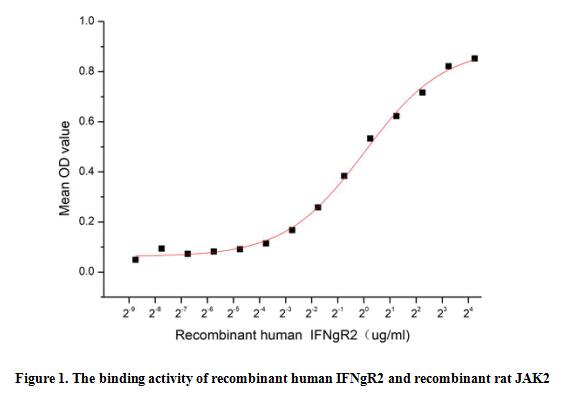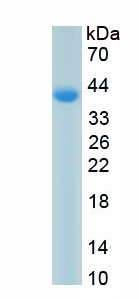Active Interferon Gamma Receptor 2 (IFNgR2) 

IFNGT1; AF-1; Interferon Gamma Transducer 1; Interferon gamma receptor accessory factor 1
Overview
Properties
- Product No.APL627Hu61
- Organism SpeciesHomo sapiens (Human) Same name, Different species.
- ApplicationsCell culture; Activity Assays.
Research use only - DownloadInstruction Manual
- CategoryCD & Adhesion molecule
- Buffer FormulationPBS, pH7.4, containing 5% Trehalose.
- Traits Freeze-dried powder, Purity > 90%
- Isoelectric Point6.7
Sign into your account
Share a new citation as an author
Upload your experimental result
Review

Contact us
Please fill in the blank.
Activity test

IFN gamma R2 (Interferon gamma receptor 2; also called IFN gamma R beta IFN gamma RII, or AF1) is a 60 64 kDa type I transmembrane glycoprotein that is a member of the class II cytokine receptor family of molecule). It is highly expressed on the surfaces of myeloid cells, moderately expressed on B cells, and poorly expressed on the surfaces of T cells. IFNγR2 is a cell-surface receptor that is required for interferon-γ signalling and therefore plays a critical immunoregulatory role in innate and adaptive immunity against viral and also bacterial and protozoal infections. IFNgR2 have been confirmed to mediate down-stream JAK-STAT signaling pathway in mammals. It is widely expressed as part of a preassembled cell surface multimeric complex. In the absence of IFN gamma, the complex contains two each of IFN gamma R1, R2 and Jak1 molecules. Binding of IFN gamma to IFN gamma R1 recruits Jak2 to IFN-gamma R2 and initiates phosphorylation, STAT1 binding, conformational changes and transcriptional regulation, which mainly inhibits proliferation and/or promotes apoptosis. A functional binding ELISA assay was conducted to detect the interaction of recombinant human IFNgR2 and recombinant rat JAK2. Briefly, biotin-linked IFNgR2 were diluted serially in PBS, with 0.01% BSA (pH 7.4). Duplicate samples of 100 μl were then transferred to JAK2-coated microtiter wells and incubated for 1h at 37℃. Wells were washed with PBST 3 times and incubation with Streptavidin-HRP for 30min, then wells were aspirated and washed 5 times. With the addition of substrate solution, wells were incubated 15-25 minutes at 37℃. Finally, add 50 µl stop solution to the wells and read at 450 nm immediately. The binding activity of IFNgR2 and JAK2 was shown in Figure 1, the EC50 for this effect is 1.02 ug/mL.
Usage
Reconstitute in 10mM PBS (pH7.4) to a concentration of 0.1-1.0 mg/mL. Do not vortex.
Storage
Avoid repeated freeze/thaw cycles. Store at 2-8°C for one month. Aliquot and store at -80°C for 12 months.
Stability
The thermal stability is described by the loss rate. The loss rate was determined by accelerated thermal degradation test, that is, incubate the protein at 37°C for 48h, and no obvious degradation and precipitation were observed. The loss rate is less than 5% within the expiration date under appropriate storage condition.
Increment services
-
 BCA Protein Quantification Kit
BCA Protein Quantification Kit
-
 Molecular Mass Marker for Protein
Molecular Mass Marker for Protein
-
 Monoclonal Antibody Customized Service
Monoclonal Antibody Customized Service
-
 Polyclonal Antibody Customized Service
Polyclonal Antibody Customized Service
-
 Protein Activity Test Experiment Service
Protein Activity Test Experiment Service
-
 Electrophoretic Mobility Shift Assay (EMSA) Experiment Service
Electrophoretic Mobility Shift Assay (EMSA) Experiment Service
-
 Buffer
Buffer
-
 Lentivirus Packaging Experiment Service
Lentivirus Packaging Experiment Service
-
 Adenovirus Packaging Experiment Service
Adenovirus Packaging Experiment Service
-
 Real Time PCR Experimental Service
Real Time PCR Experimental Service
-
 Spike RBD Protein (S-RBD)
Spike RBD Protein (S-RBD)
-
 Protein G
Protein G
-
 Protein A
Protein A







